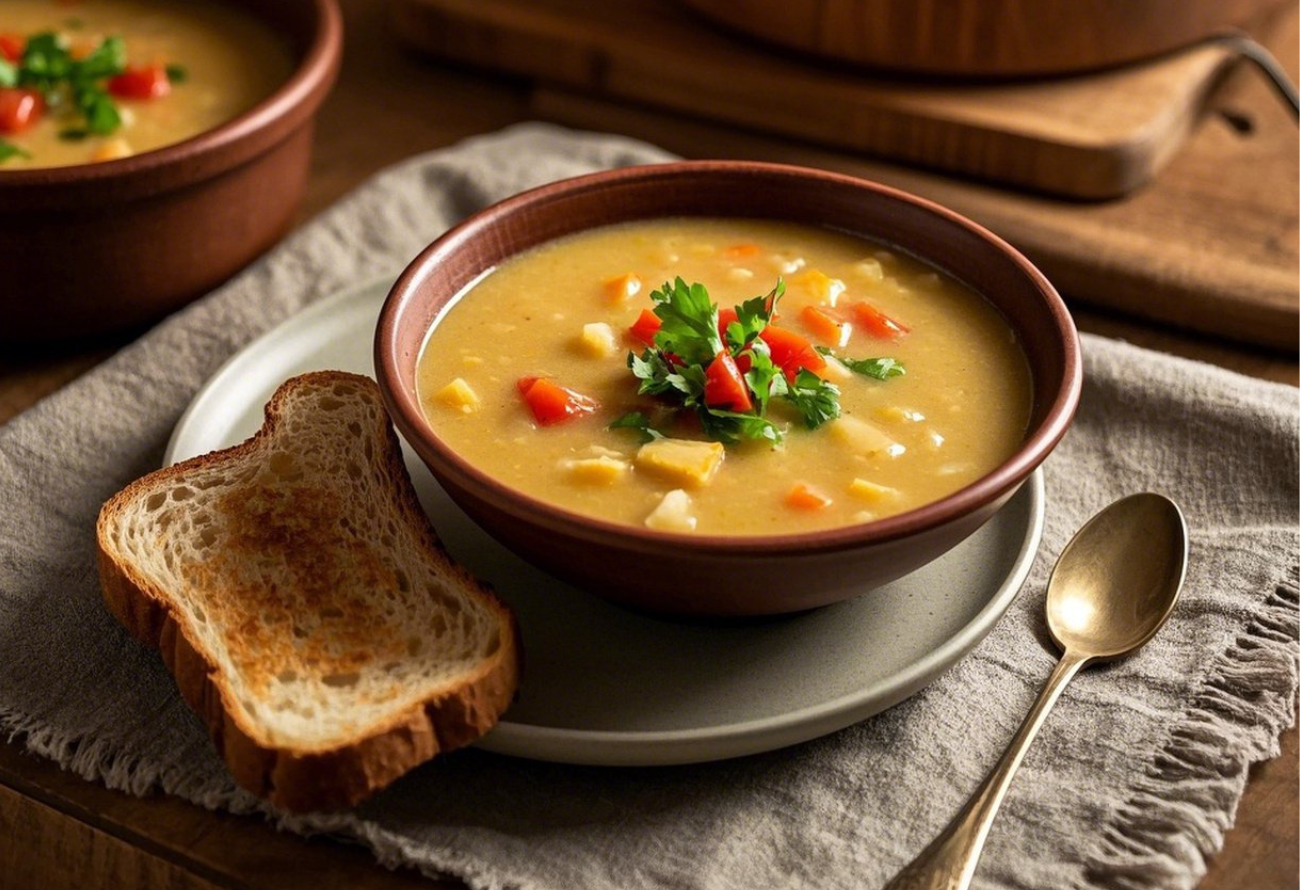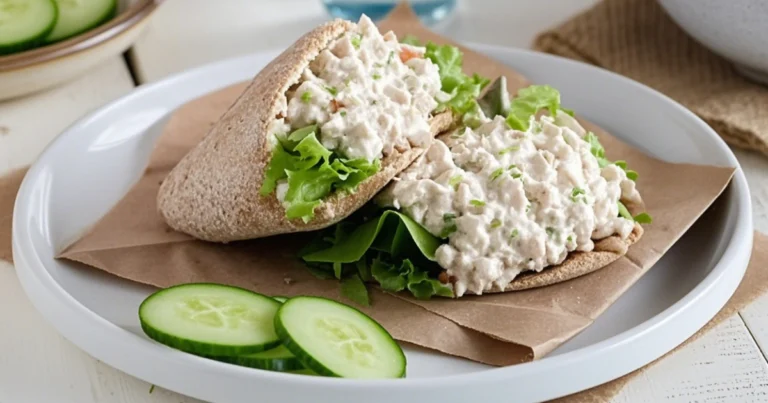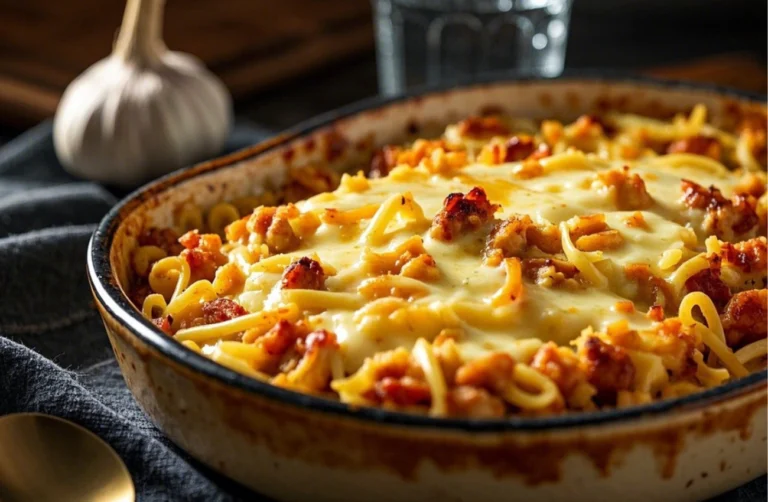Quick and Easy Chicken Noodle Soup – Ready in 20 Minutes!
Table of Contents
Remember that feeling? Walking through your front door on a blustery winter afternoon, instantly enveloped by the warm, aromatic embrace of chicken soup simmering on the stove. The scent alone seems to thaw the chill from your bones, promising comfort in every spoonful.
Chicken noodle soup transcends mere sustenance—it’s liquid nostalgia, a bowl of memories that connects us to childhood kitchens and nurturing hands. When illness strikes or the world feels particularly harsh, we instinctively crave this golden elixir that somehow makes everything feel manageable again.
But let’s be honest—traditional homemade chicken soup demands time, a luxury many of us simply don’t have during hectic weeknights when comfort is most needed. Between work deadlines, family obligations, and the perpetual quest for work-life balance, spending hours tending to a simmering pot simply isn’t realistic.
That’s where this recipe changes everything. This quick 20-minute chicken noodle soup recipe delivers all the comfort without the wait, proving that homemade goodness doesn’t require sacrificing your entire evening. Ready to transform your weeknight meal rotation? Let’s dive in.
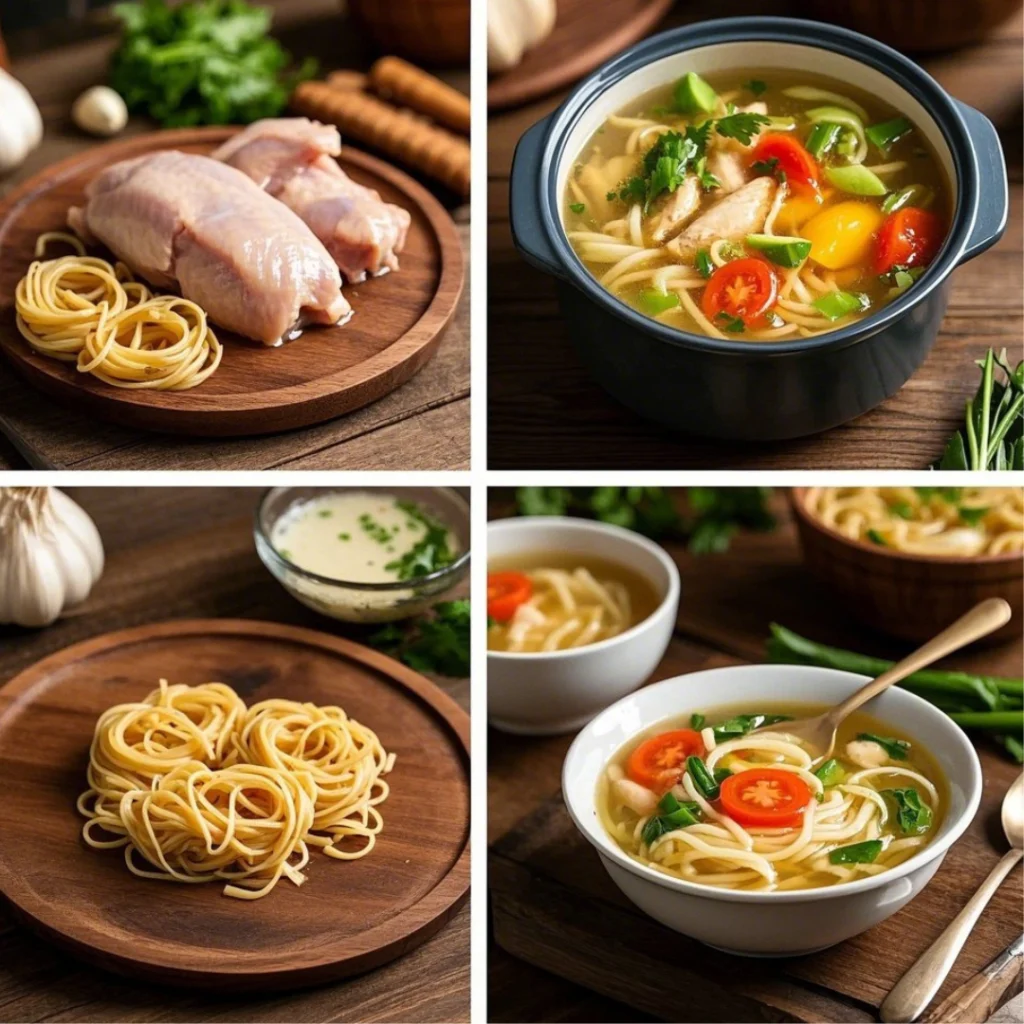
Why This 20-Minute Chicken Noodle Soup Will Become Your Go-To Recipe
Most quick-cook soup recipes cut corners in ways that compromise flavor, leaving you with a bowl that’s simply adequate rather than exceptional. This recipe takes a different approach. By strategically selecting ingredients that deliver maximum impact in minimal time, you’ll achieve a soup that tastes like it simmered all afternoon—without the afternoon-long commitment.
This soup works particularly well because it capitalizes on smart preparation techniques and ingredient choices. The chicken is cut into small pieces that cook quickly yet remain tender. The vegetables are sliced thin for rapid softening without turning mushy. And the broth is enhanced with aromatics that infuse flavor in minutes rather than hours.
Beyond convenience, this soup offers remarkable versatility. Perfect for cold winter evenings, it equally serves as a light summer lunch option. When seasonal illnesses strike, its warm, soothing qualities and easily digestible ingredients make it the perfect nourishment. For busy parents, it’s a nutritious option that even picky eaters typically enjoy.
Most importantly, this homemade version delivers substantially more nutritional value than processed alternatives. Store-bought soups typically contain excessive sodium, preservatives, and artificial ingredients. Your quick homemade version provides lean protein, fresh vegetables, and the ability to control exactly what goes into your family’s bowls.
Ingredients: Everything You Need for Perfect Quick Chicken Noodle Soup
The beauty of this recipe lies in its simplicity—basic ingredients combining to create something extraordinary. Let’s explore what you’ll need to create this weeknight wonder:
Main Ingredients Table
| Ingredient | Amount | Notes |
|---|---|---|
| Boneless chicken breast | 1 pound | Cut into small, bite-sized pieces |
| Olive oil | 2 tablespoons | For sautéing vegetables |
| Yellow onion | 1 medium | Finely diced |
| Carrots | 2 medium | Thinly sliced |
| Celery | 2 stalks | Thinly sliced |
| Garlic | 3 cloves | Minced |
| Chicken broth | 6 cups | Low-sodium preferred |
| Wide egg noodles | 2 cups | Or pasta of choice |
| Bay leaf | 1 | Optional |
| Fresh thyme | 2 sprigs | Or 1/2 teaspoon dried |
| Salt and pepper | To taste | |
| Fresh parsley | 2 tablespoons | Chopped, for garnish |
Don’t worry if your pantry doesn’t perfectly match this list. Cooking should accommodate your circumstances, not create additional stress. The following substitutions work beautifully without compromising the essential character of your soup:
Potential Substitutions Table
| Ingredient | Substitution Options |
|---|---|
| Chicken breast | Rotisserie chicken or leftover cooked chicken |
| Egg noodles | Any short pasta, rice, or gluten-free alternatives |
| Fresh herbs | Dried herbs (use 1/3 the amount) |
| Chicken broth | Vegetable broth or bouillon cubes with water |
Equipment Needed
Simplicity extends to the equipment required. You likely already have everything you need in your kitchen:
- Large pot or Dutch oven
- Cutting board and knife
- Measuring cups and spoons
- Wooden spoon or spatula
Nothing fancy required—just the basics that make cooking accessible regardless of your kitchen setup.
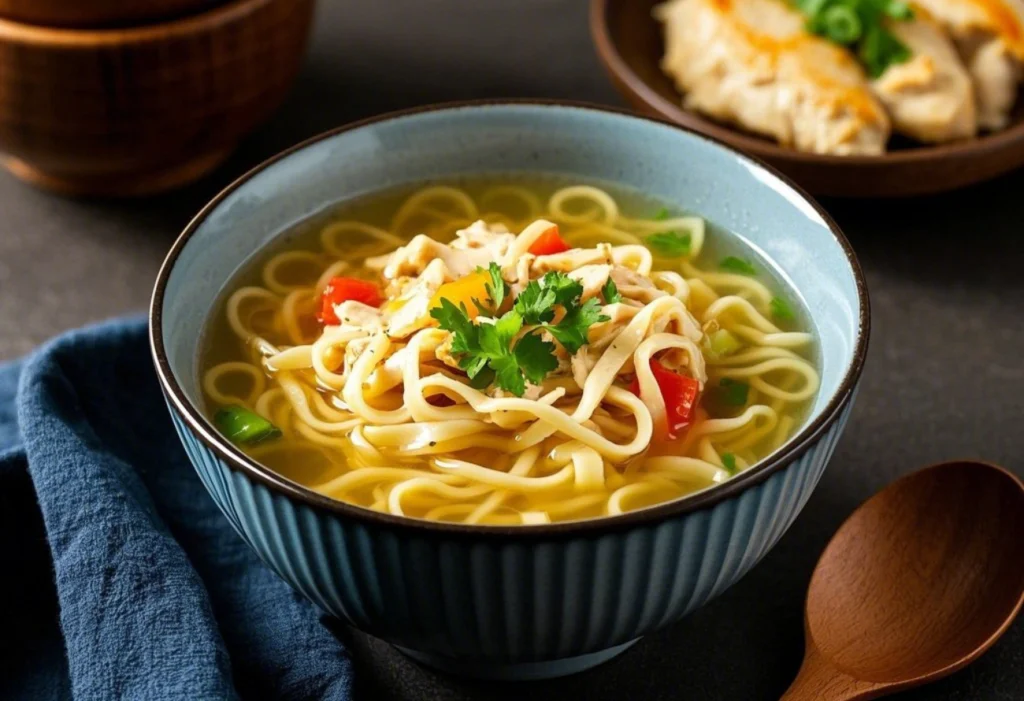
Step-by-Step Instructions: Making Your 20-Minute Chicken Noodle Soup
The key to executing this recipe successfully lies in organization and timing. By following these clearly defined steps, you’ll maintain the promised 20-minute timeframe without sacrificing quality.
1. Prep Your Ingredients (5 minutes)
Begin by organizing your workspace. This initial investment of time creates efficiency throughout the cooking process.
Cut your chicken into pieces approximately 1/2-inch in size. This consistent sizing ensures even, rapid cooking—critical for maintaining our 20-minute timeline. Larger chunks require longer cooking times that would extend beyond our goal.
Next, prepare your vegetables. Aim for uniformity in your dice and slices. The onions should be finely diced (approximately 1/4-inch pieces), while the carrots and celery benefit from thin slices (about 1/8-inch thick). This precision in preparation frontloads your effort, allowing the actual cooking to proceed smoothly.
Measure remaining ingredients and position them near your cooking surface for easy access. This organization technique, known professionally as “mise en place,” prevents mid-cooking scrambles that waste precious minutes.
2. Sauté the Aromatics (3 minutes)
Heat your olive oil in a large pot over medium-high heat until it shimmers but doesn’t smoke. Add your prepared onions, carrots, and celery to the hot oil, stirring occasionally. You’re not looking to caramelize here—just to soften the vegetables slightly and release their flavors into the oil.
After about 2.5 minutes, when the onions begin to turn translucent at the edges, add your minced garlic. Garlic requires significantly less cooking time than other aromatics—incorporating it now prevents bitterness from overcooking while still extracting its essential flavor compounds.
3. Cook the Chicken (4 minutes)
Add your diced chicken directly to the aromatics. Season immediately with approximately 1/2 teaspoon salt and 1/4 teaspoon freshly ground black pepper. The seasoning at this stage begins building flavor layers that distinguish homemade soup from commercial versions.
Stir frequently, cooking just until the exterior of the chicken pieces loses its raw appearance. The interiors will likely remain slightly undercooked—this is intentional. The chicken will complete its cooking during the simmering process, preventing the dreaded toughness that comes from overcooked poultry.
4. Add Liquid and Simmer (5 minutes)
Pour your chicken broth into the pot, using it to deglaze by scraping any flavorful browned bits from the bottom with your wooden spoon. These browned bits contain concentrated flavor compounds that enrich your broth tremendously.
Add your bay leaf and thyme sprigs (or dried thyme if using). Increase heat to bring the mixture to a boil, then immediately reduce to maintain a steady simmer. During this simmering period, the flavors begin melding while the chicken gently finishes cooking through.
5. Cook the Noodles (5 minutes)
Add your egg noodles directly to the simmering soup. While some recipes recommend cooking pasta separately, this direct approach serves two purposes: it allows the noodles to absorb the soup’s flavors, and it streamlines the process for our 20-minute timeline.
Stir occasionally to prevent sticking, especially along the pot’s bottom. The noodles will typically require 5-7 minutes to reach an ideal al dente texture, where they retain slight firmness rather than becoming mushy. Test a noodle at the 5-minute mark to gauge progress.
6. Finish and Serve (1 minute)
Once your noodles have reached the desired consistency, remove the bay leaf and thyme sprigs—they’ve completed their flavor-infusing mission. Taste the soup and adjust seasonings, typically adding additional salt and pepper according to your preference.
Stir in your fresh parsley just before serving. This late addition preserves its bright color and fresh flavor, providing visual appeal and a flavor counterpoint to the deeper, developed tastes in your soup.
Ladle into bowls and serve immediately, allowing the comforting aroma to work its magic before the first spoonful even crosses your lips.
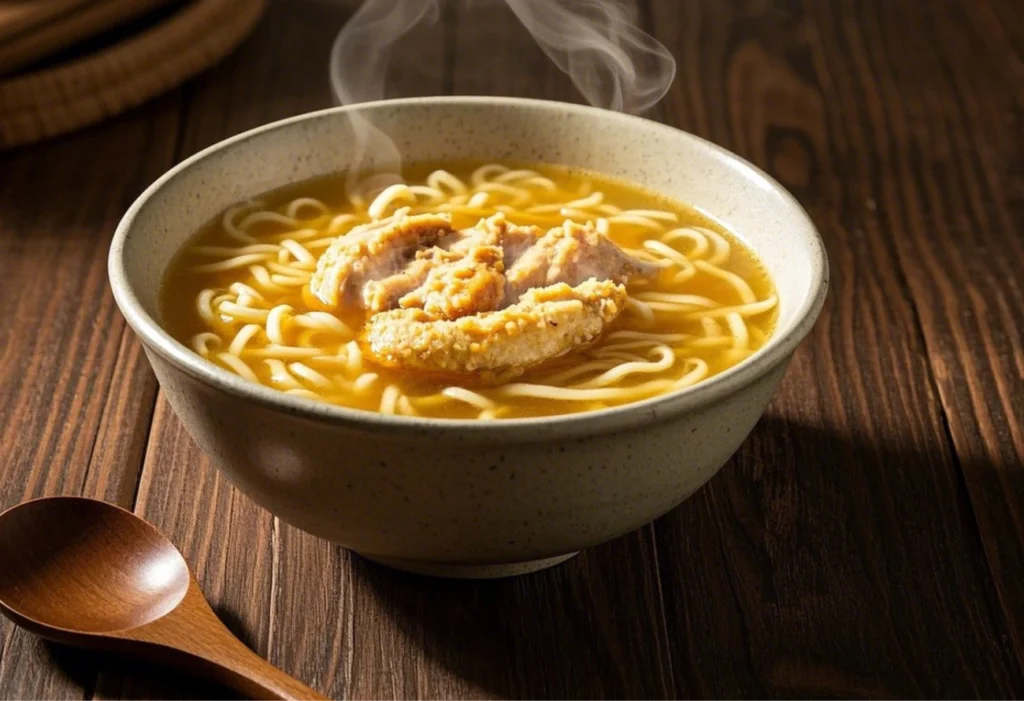
Time-Saving Tips for Perfect Chicken Noodle Soup
Even with our streamlined approach, further efficiencies can help on particularly hectic evenings:
- Pre-chopped mirepoix (the onion, carrot, celery combination) is available in many grocery store produce sections, saving precious prep minutes.
- Rotisserie chicken, shredded or chopped, eliminates raw poultry handling and reduces cooking time by approximately 4 minutes.
- Keep homemade broth portions frozen in ice cube trays or small containers for quick defrosting, offering superior flavor without added time.
- Prepare a double batch during your weekend cooking sessions and freeze individual portions in silicone molds for future meals.
- Electric kettles bring water to boiling point faster than stovetops. Use this pre-boiled water when preparing broth from concentrates or bouillon.
Storage and Reheating Instructions
Proper storage techniques preserve both flavor and food safety:
Refrigerator storage: Transfer cooled soup to shallow, airtight containers. Shallow containers facilitate rapid cooling, minimizing bacterial growth risk. Consume within 3 days for optimal quality, though the soup remains safe slightly longer.
Freezer storage: For extended preservation, freeze soup without noodles when possible. Noodles tend to disintegrate after freezing and reheating, losing their textural appeal. Store broth, vegetables, and chicken in freezer-safe containers for up to 3 months. When ready to serve, thaw, heat, and add freshly cooked noodles.
Reheating tips: Gentle reheating preserves texture and flavor. On stovetops, warm soup over medium-low heat, stirring occasionally. Microwaving works for individual portions—cover with a microwave-safe lid, leaving slight venting, and heat in one-minute intervals, stirring between. If the soup thickens during storage (as noodles absorb liquid), add small amounts of broth or water when reheating to restore original consistency.
Why Homemade Chicken Noodle Soup Is Worth the (Minimal) Effort
The comparison between homemade and commercial alternatives becomes particularly stark when examining nutritional profiles. Most canned chicken noodle soups contain between 800-1000mg sodium per serving—approaching half the recommended daily limit in a single bowl. Your homemade version typically contains 300-400mg per serving when using low-sodium broth.
Beyond sodium, commercial soups often contain preservatives like calcium disodium EDTA, modified food starch for texture enhancement, and flavor additives like disodium inosinate and guanylate. Your 20-minute version eliminates these unnecessary additions.
Chicken soup’s reputation as a cold remedy actually has scientific backing. Research published in the journal Chest suggested that chicken soup may inhibit neutrophil migration, potentially mitigating upper respiratory tract infection symptoms. Additionally, proper hydration, easily achieved through soup consumption, helps thin mucus secretions. Your homemade version optimizes these benefits through fresh ingredients and controlled preparation.
From a financial perspective, homemade chicken soup represents remarkable value. A pot serving 4-6 people typically costs $8-12 in ingredients, compared to premium prepared soups at $3-4 per single serving. The minimal additional effort delivers substantial savings alongside quality improvements.
Recipe Variations: Make It Your Own
While the basic recipe stands perfectly on its own, customization offers endless possibilities:
Spicy version: Add 1/4-1/2 teaspoon red pepper flakes with the aromatics, or offer hot sauce at the table for individualized heat levels. The capsaicin in spicy ingredients potentially provides additional decongestant benefits during cold season.
Creamy version: After removing from heat, stir in 1/4 cup heavy cream or coconut milk for luxurious richness. This variation works particularly well when serving soup as a main course, providing additional satiety.
Herb-forward: Experiment beyond traditional thyme and parsley. Fresh dill brings brightness perfect for spring, tarragon offers licorice undertones that complement chicken beautifully, and rosemary introduces piney depth perfect for winter evenings.
Lemon-bright: Just before serving, add 1-2 tablespoons fresh lemon juice and 1/2 teaspoon zest. This Mediterranean-inspired variation enhances the soup’s refreshing qualities while potentially boosting vitamin C content.
Vegetable-packed: In the final minutes of cooking, add 1/2 cup frozen corn, peas, or chopped leafy greens like spinach or kale. This variation increases nutritional density and introduces complementary textures.
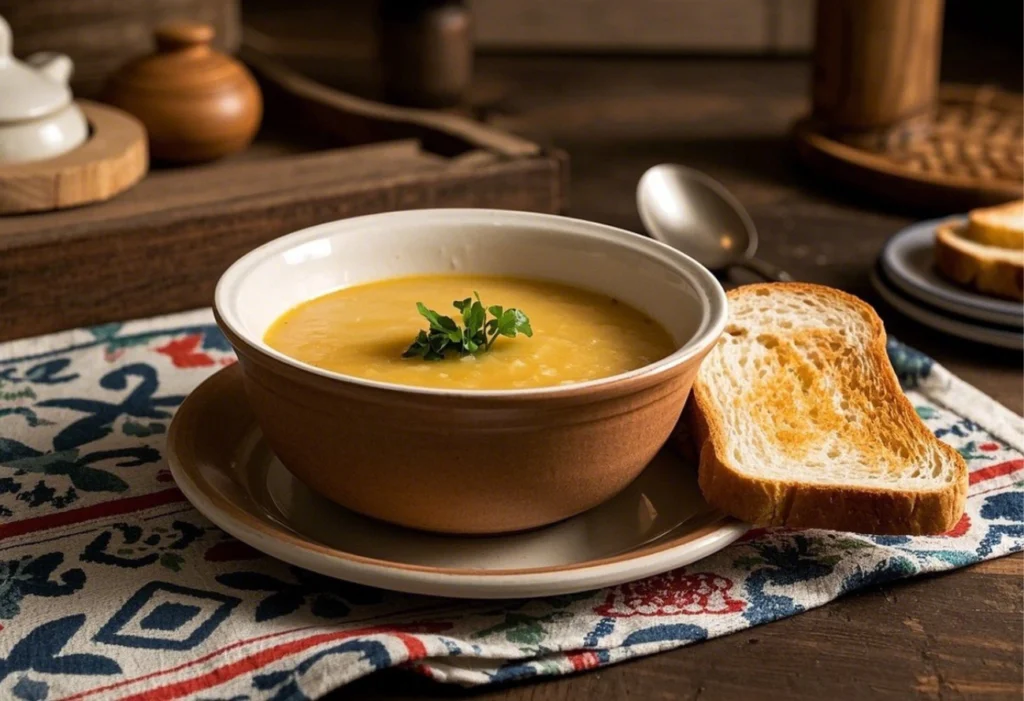
Conclusion: Comfort Food Doesn’t Have to Take All Day
The tradition of chicken noodle soup represents something deeply human—our capacity to transform simple ingredients into nourishment that satisfies both body and spirit. This 20-minute version honors that tradition while acknowledging contemporary realities. It offers proof that meaningful cooking remains possible even within the constraints of modern schedules.
By incorporating this recipe into your regular rotation, you reclaim the power of homemade comfort without sacrificing precious time. The minutes saved can be redirected toward what truly matters—perhaps enjoying that soup with family or friends, sharing stories across steaming bowls that warm hands and hearts simultaneously.
Next time life’s demands seem overwhelming, remember that comfort remains within reach. Sometimes, the most nurturing act of self-care involves just 20 minutes in the kitchen, creating something that reminds you of simpler times while perfectly addressing present needs.
Why not make tonight the night you discover how accessible homemade comfort can be? Your future self—perhaps tired, perhaps slightly under the weather, certainly deserving of care—will thank you profoundly.
Share your experience with this quick chicken noodle soup in the comments below! Did you try any variations? How did it compare to longer-simmered versions? Your insights might help fellow soup enthusiasts discover their new favorite weeknight solution.
Frequently Asked Questions About Quick Chicken Noodle Soup
How can I make chicken noodle soup even faster?
This chicken noodle soup recipe is already quick at 20 minutes, but you can save additional time by using pre-cooked rotisserie chicken, pre-cut vegetables, and quick-cooking noodles like thin egg noodles or vermicelli. Some home cooks maintain a “soup starter kit” in their freezer—a container with pre-chopped mirepoix that can be added directly to hot oil without thawing. This preparation strategy alone can save 3-4 minutes.
Can I make this chicken noodle soup recipe in an Instant Pot?
Yes! This chicken noodle soup adapts beautifully to the Instant Pot. Use the sauté function for the vegetables and chicken, then pressure cook everything except the noodles for 3 minutes. Release pressure, add noodles, and use sauté function until noodles are tender. The total time remains similar, but the hands-on portion decreases significantly, allowing you to attend to other tasks while the pressure cooker works its magic.
What makes homemade chicken noodle soup healthier than canned?
Homemade chicken noodle soup contains significantly less sodium, no preservatives, and fresher ingredients than most canned varieties. You can also control the quality of ingredients, including using organic vegetables and antibiotic-free chicken. Additionally, canned soups typically undergo extensive processing that diminishes nutrient content, particularly water-soluble vitamins. Your fresh preparation preserves these nutritional elements while eliminating BPA concerns associated with many canned products.
Can I use frozen chicken for this quick chicken noodle soup recipe?
For a 20-minute recipe, fresh chicken works best. However, if you only have frozen chicken, thaw it completely in the microwave first, or use the recipe variation with rotisserie chicken instead. Partially frozen chicken presents food safety challenges and extends cooking time beyond our 20-minute goal. If using chicken directly from frozen is your only option, consider slicing it thinly while still partially frozen (easier than when fully frozen), which enables faster cooking.
How do I store leftover chicken noodle soup?
For best results, store the soup and noodles separately. If already combined, refrigerate in an airtight container for up to 3 days. The noodles will continue to absorb broth, so you may need to add additional broth when reheating. For optimal texture preservation, consider slightly undercooking the noodles initially if you anticipate storing leftovers, allowing them to reach perfect doneness during reheating without becoming mushy.
Why is my chicken noodle soup bland?
If your chicken noodle soup lacks flavor, try adding more salt, a splash of soy sauce, or a teaspoon of better-than-bouillon paste. Using homemade chicken stock instead of store-bought broth can also significantly improve flavor. Don’t overlook acid’s importance in flavor development—a teaspoon of white wine vinegar or lemon juice can brighten flavors without making the soup taste sour. Finally, ensure your herbs are fresh or recently purchased, as older dried herbs lose potency dramatically.
What sides go well with quick chicken noodle soup?
This chicken noodle soup recipe pairs perfectly with crusty bread, a simple green salad, or grilled cheese sandwiches for a complete meal that’s ready in under 30 minutes. For a lighter accompaniment, try sourdough crostini rubbed with garlic and drizzled with olive oil. When serving for lunch, consider a half sandwich with complementary flavors—turkey or chicken salad works particularly well. For dinner, a simple side of roasted vegetables can add textural contrast and additional nutritional benefits.

